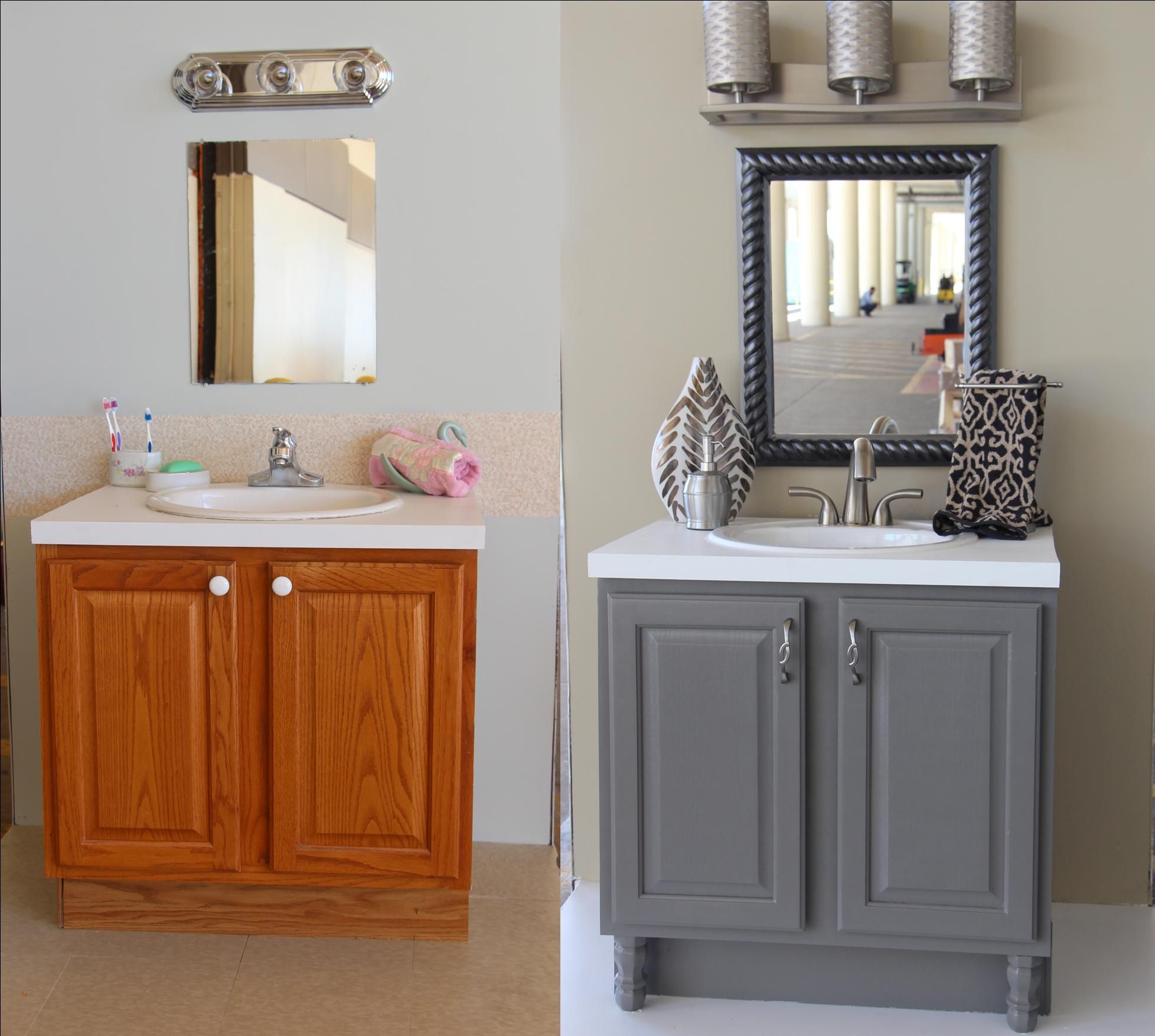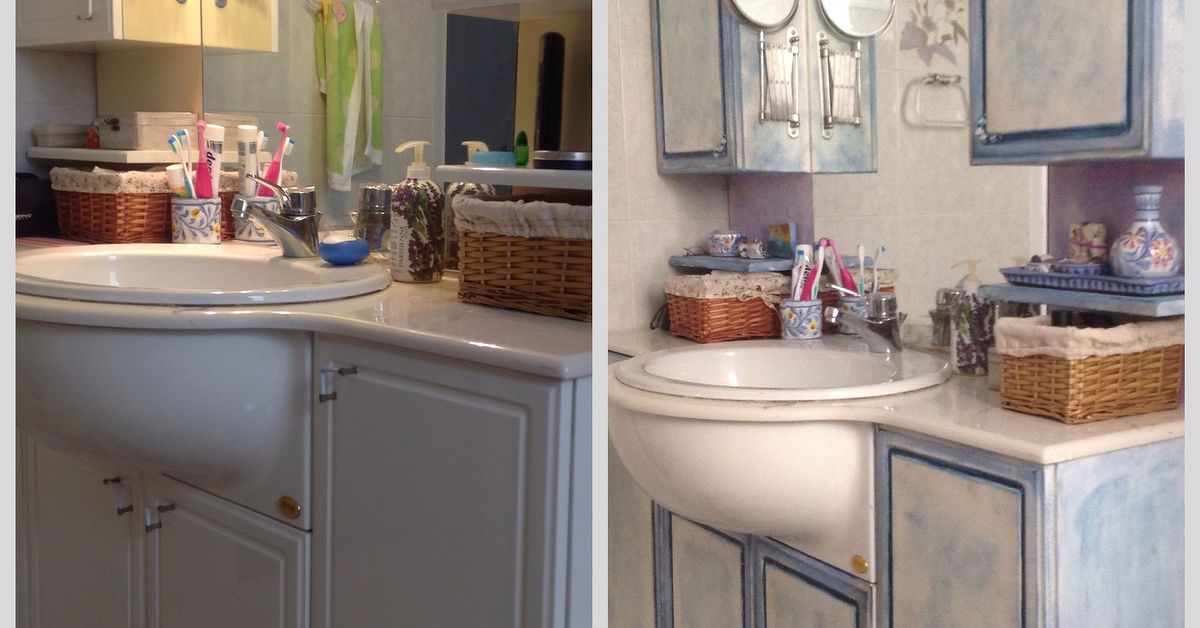Preparing Your Bathroom Cabinets

Before you can unleash the magic of chalk paint on your bathroom cabinets, you need to prepare them for a flawless finish. This involves a few essential steps to ensure the paint adheres properly and lasts for years to come. Think of it as setting the stage for a masterpiece!
Cleaning Your Bathroom Cabinets
A clean surface is the foundation of any successful painting project. Bathroom cabinets are prone to grime, soap scum, and even mildew, so a thorough cleaning is crucial.
- Start by removing all hardware, including knobs, pulls, and hinges. This allows you to clean every nook and cranny without obstruction.
- Mix a solution of warm water and mild dish soap. Avoid harsh cleaners or abrasives that could damage the cabinet’s finish.
- Gently scrub the cabinets with a soft cloth or sponge, paying special attention to areas with heavy grime.
- Rinse the cabinets thoroughly with clean water and allow them to dry completely. This ensures that no soap residue remains, which can interfere with paint adhesion.
Sanding Your Bathroom Cabinets
Sanding helps create a smooth surface for the chalk paint to adhere to, improving the overall finish and minimizing imperfections.
- Start with a fine-grit sandpaper (120-grit or higher). This removes any remaining dirt or residue and creates a slightly rough surface for the paint to grip.
- Sand in the direction of the wood grain, applying gentle pressure. Avoid sanding too aggressively, as this can damage the cabinet’s surface.
- After sanding, wipe away dust with a tack cloth or a damp cloth. This ensures that no dust particles remain, which can interfere with the paint’s adhesion.
Filling Holes and Imperfections
Before painting, address any holes or imperfections on your bathroom cabinets. This ensures a smooth, professional finish.
- Use wood filler to fill any holes left by removed hardware or other imperfections.
- Apply the filler with a putty knife, ensuring it’s level with the surrounding surface.
- Allow the filler to dry completely according to the manufacturer’s instructions.
- Once dry, sand the filler smooth with fine-grit sandpaper. This blends the filler seamlessly with the cabinet’s surface.
Priming Your Bathroom Cabinets, Painting bathroom cabinets with chalk paint
Priming is an essential step before painting, especially when using chalk paint. It helps the paint adhere better, creates a more uniform finish, and prevents the wood’s natural tannins from bleeding through.
- Choose a primer specifically designed for use with chalk paint. These primers are formulated to provide optimal adhesion and prevent the paint from reacting with the underlying surface.
- Some popular options include Zinsser Bulls Eye 1-2-3 Primer, Kilz 2 Primer, and Valspar’s Bonding Primer.
- Apply the primer with a brush or roller, following the manufacturer’s instructions.
- Allow the primer to dry completely before applying the chalk paint. This ensures that the primer has time to cure and create a strong base for the paint.
Applying Chalk Paint to Bathroom Cabinets

Now that your cabinets are prepped and ready, it’s time to get creative with chalk paint! Applying chalk paint to your bathroom cabinets can be a fun and rewarding experience. With a little patience and care, you can achieve a beautiful and unique finish that will transform your bathroom.
Choosing the Right Application Technique
Applying chalk paint can be done using various techniques, each with its own advantages and disadvantages. The best method for you will depend on the size and shape of your cabinets, your level of experience, and the desired finish.
- Brushing: Brushing is a popular method for applying chalk paint, especially for detailed areas and smaller cabinets. It allows for precise application and control over the paint’s flow.
- Rolling: Rolling is a great option for larger surfaces like cabinet doors and sides. It’s a quick and efficient method, resulting in a smooth and even finish.
- Spraying: Spraying offers the fastest and most efficient application, especially for larger projects. However, it requires specialized equipment and proper ventilation.
Tips for Achieving a Smooth and Even Finish
Regardless of the application technique you choose, it’s crucial to apply chalk paint in thin, even coats. This ensures a smooth and even finish without streaks or brush marks.
- Use a high-quality chalk paint brush: A good quality brush with soft bristles will help create a smooth finish and prevent streaks.
- Load your brush lightly: Avoid overloading your brush with paint, as this can lead to drips and uneven coverage.
- Use long, smooth strokes: Apply the paint in long, even strokes, blending each stroke into the next.
- Work in small sections: Divide the cabinet surface into smaller sections, applying the paint in one direction for each section.
- Allow the paint to dry completely between coats: Ensure each coat of chalk paint is completely dry before applying the next coat. This will prevent smudging and uneven coverage.
The Importance of Multiple Thin Coats
Applying multiple thin coats of chalk paint is crucial for achieving a smooth and even finish. One thick coat can result in uneven coverage, streaks, and a bumpy surface.
It’s better to apply several thin coats than one thick coat.
Thin coats allow the paint to dry evenly and prevent the paint from cracking or peeling. It also allows the color to build up gradually, creating a rich and vibrant finish.
Finishing and Protecting Your Chalk Painted Cabinets: Painting Bathroom Cabinets With Chalk Paint

Chalk paint is a wonderful choice for transforming bathroom cabinets, but it needs a final layer of protection to withstand the moisture and wear and tear of this high-traffic area. Sealing your chalk paint not only enhances its durability but also adds a beautiful finish.
Sealing Options for Chalk Painted Cabinets
The choice of sealant depends on your desired level of protection and the overall look you want to achieve. Here are some popular options:
- Wax: Wax provides a soft, natural finish and enhances the chalk paint’s matte texture. It’s easy to apply and can be reapplied as needed. However, wax offers the least protection against moisture and scratches. It’s ideal for a vintage, rustic look and is best suited for cabinets that aren’t subjected to heavy use.
- Polycrylic: Polycrylic is a water-based sealant that provides a durable, clear finish. It’s a good choice for bathroom cabinets as it’s moisture-resistant and easy to clean. Polycrylic is available in both matte and satin finishes. It’s a good option for a modern or contemporary look and provides a more robust protective layer compared to wax.
- Lacquer: Lacquer is a solvent-based sealant that offers the highest level of protection against moisture, scratches, and stains. It creates a hard, durable finish with a high gloss. Lacquer is best suited for cabinets that are heavily used or exposed to moisture. However, it can be more difficult to apply than wax or polycrylic and may require professional application.
Applying the Sealant
No matter which sealant you choose, proper application is key to achieving a durable and beautiful finish. Here are some general tips:
- Prepare the surface: Before applying any sealant, ensure the chalk paint is completely dry. Lightly sand the surface with fine-grit sandpaper to smooth out any imperfections and create a better adhesion for the sealant.
- Apply in thin coats: Apply the sealant in thin, even coats. Too much sealant can cause it to drip or become cloudy. Allow each coat to dry completely before applying the next.
- Follow the manufacturer’s instructions: Always read and follow the manufacturer’s instructions for the specific sealant you’re using. This will ensure you achieve the best results and avoid any potential issues.
Choosing the Right Sealant for Your Bathroom Cabinets
Consider the following factors when choosing the right sealant for your bathroom cabinets:
- Level of protection: If your bathroom cabinets are heavily used or exposed to moisture, choose a sealant that offers a high level of protection, such as lacquer. For cabinets that are less used, wax or polycrylic may be sufficient.
- Desired finish: Wax provides a soft, natural finish, while polycrylic is available in both matte and satin finishes. Lacquer offers a high gloss finish.
- Ease of application: Wax is the easiest sealant to apply, while lacquer can be more challenging.
Painting bathroom cabinets with chalk paint – Chalk paint is a super easy way to give your bathroom cabinets a totally new look, and it’s totally renter-friendly! You can easily paint over it with a new color when you move out. If you’re looking for a new place to live, you might want to check out 2 bedroom apartments in Union, NJ.
Once you’ve settled in, you can start brainstorming fun bathroom cabinet colors!
Painting bathroom cabinets with chalk paint is a super easy way to give them a fresh, modern look. It’s a lot like what people do with white kitchen cabinets with glass tile backsplash , except you’re working with a smaller space.
The great thing about chalk paint is that it’s super forgiving, so you don’t have to be a pro to get a great result. Plus, you can always change the color later if you get bored!
